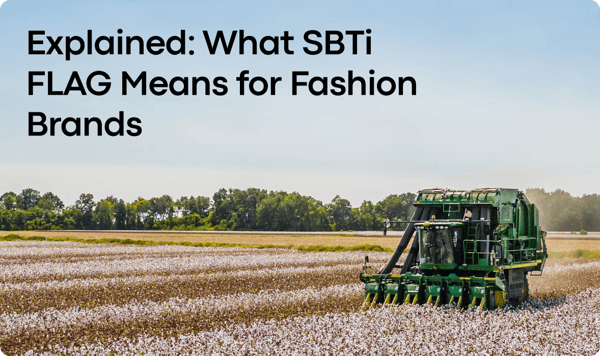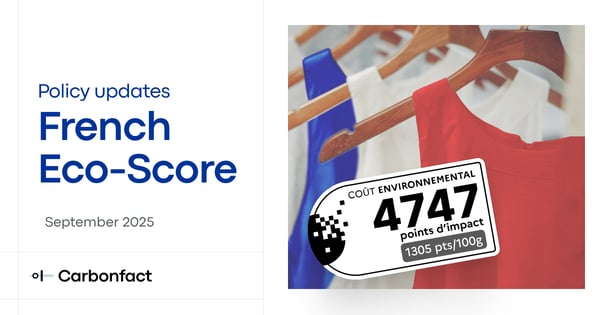"You Ask, We Answer" – brought to you by Carbonfact's Head of Science. Each week, Dr. Laurent Vandepaer, together with Carbonfact's Science Associate Vincent Carrières, answers one of your questions about sustainable materials, manufacturing impact, and energy transition in the apparel and footwear industry.
Laurent previously led sustainability and innovation efforts at On and performed LCAs for brands like Arc'teryx. Vincent joined Carbonfact after three years as a sustainability expert at Quantis, where he specialized in LCA and corporate footprinting.
30% of our material basket is leather, but we’re struggling to find reliable LCAs. What should we be aware of while accurately assessing the environmental impact of leather?
Asked by the Head of Sustainability from luxury brand
Leather’s unique fiber structure creates an irregular yet incredibly resilient pattern, making it a material of choice for everything from luxury handbags to footwear. Understanding this in the context of circularity is essential — focusing on leather’s full life cycle rather than only one stage of production.
Most commercial leather is derived from the hides of animals raised primarily for meat, positioning leather as a byproduct of the livestock industry rather than a main driver of it. However, because it is intrinsically linked to agriculture, leather production is associated with substantial environmental concerns, including land use and deforestation, methane emissions, and water consumption.
While the global trade in leather goods surpasses $100 billion annually, eclipsing the $60-billion trade in meat, hides only account for around 1.5% to 3.5% of slaughterhouse revenue, depending on literature sources. As a result, when environmental impacts are allocated based on economic value, only a small fraction (around 2%) of animal live weight production is attributed to leather, with the vast majority assigned to meat. This economic allocation method can seem counterintuitive, especially given the high downstream value and long-lasting use of leather products.
Beyond farming, the transformation of raw hides into finished leather requires multiple chemical and mechanical processes, each carrying environmental and social risks. From tanning methods to waste management, understanding the full life cycle of leather is crucial for brands aiming to reduce their impact, align with the GHG Protocol’s FLAG Guidance, as well as comply with regulations such as the EU Deforestation Regulation (EUDR).
Market Share of Different Leather Types per Animal

Market shares of different leather types per animal, in 2023, based on Textile Exchange source.
As seen from the graph above, 13 million tonnes of hides were produced in 2023. Leather can be produced from the skin of different animals depending on required characteristics and applications.
- A large majority of leather production is made from cattle skin, including cow and calf. They provide a durable, thick and versatile leather that can be used for bags, boots, jackets, and a variety of other heavy duty leather goods.
- Sheep leather is generally softer and more lightweight, but less durable. It can be used for smaller high-end fashion items.
- Goat leather is strong and durable, and can be used in workwear applications.
- Other types of exotic leather (snake, crocodile…) can also be used quite frequently in luxury applications.These leather types are often associated with a significantly higher environmental impact and can generate overharvesting of some wild or endangered species, as well as increased tanning impacts.
Allocation of the Environmental Impact of Leather
Leather is a co-product of a complex supply chain that includes three main stages:
- Farm level – where cattle are raised for milk and meat
- Slaughterhouse – where hides are separated from meat and other parts
- Tanning process – where hides are converted into finished leather
In leather production, environmental impacts must be allocated across different co-products at various stages of the supply chain (milk, meat, leather, bones, etc.). Two main allocation methods are commonly used in Life Cycle Assessments (LCA):
- Biophysical allocation distributes impacts based on physical relationships, such as protein or energy content.
- Economic allocation assigns impacts based on the relative market value of each co-product.
The Product Environmental Footprint Category Rules (PEFCR) for Apparel and Footwear follow biophysical allocation at the farm level and economic allocation at the slaughterhouse stage.
- At the farm level, cattle are often raised for both milk and meat (live weight), and sometimes also for wool (in ovines or caprines). According to PEFCR, 88% of environmental impact is allocated to milk and only 12% to live weight (which includes meat, leather, bones, etc.).
- During the tanning process, the skins can be split horizontally amongst different layers: the top grain layer, considered the most valuable and durable, and the split layers, often used for lower-grade leather products. An allocation based on the protein content is generally applied between these layers.
- At the slaughterhouse, multiple outputs like meat, hides, and bones are produced. Here, PEFCR uses economic allocation, assigning environmental impact based on the market value of each by-product.
However, this economic value is variable and can significantly affect LCA results. For example, switching the economic allocation for hides from 1.8% to 3.5% in our analysis changed the carbon footprint by around 30%.
Some approaches treat leather as a waste product with no upstream impact, but this allocation is not accepted by standard LCA practice or the PEFCR.
Leather Working Group (LWG) - Leather LCA (2024)
The Leather Working Group (LWG) Life Cycle Assessment (2024) highlights the key environmental impacts of leather production, analyzing eight impact categories including Global Warming Potential (GWP), eutrophication, and water use.
A key finding: producing 1 m² of finished leather results in 22.48 kg CO₂e in GWP. Of this, 68% is attributed to upstream farming and slaughtering, highlighting the significant impact of leather’s link to the livestock industry.
However, the study also reveals that core leather manufacturing processes contribute significantly to environmental impact, particularly in the post-tanning stage. This phase is the most impactful within manufacturing, driving abiotic depletion (the depletion of non-living resources such as fossil fuels) and freshwater ecotoxicity. Notably, chemicals play the dominant role in these environmental impacts, surpassing even raw materials in their overall effect.
This data is accessible to LWG members and has been integrated into the Carbonfact platform to help brands assess and reduce leather-related emissions more accurately.
Leather Environmental Impact Allocation: PEFCR vs. LWG LCA
The Product Environmental Footprint Category Rules (PEFCR) strict guidelines for calculating leather’s environmental impact, requiring specific allocation methods for hides after slaughter. One key rule is that 3.5% of total cattle farming emissions must be assigned to hides based on their economic value.
The LWG LCA, however, modifies this allocation, assigning only 1.8%, which significantly lowers the reported upstream impact.
Another major difference is leather thickness assumptions — PEFCR assumes 1.9mm for footwear and leather goods, leading to a higher material density and higher emissions per square meter. In contrast, LWG LCA reports up to four times lower upstream impact than PEFCR’s default model due to differences in:
- Cattle farming emission calculations
- How leather’s share of total cattle production is allocated
In the interest of accuracy, Carbonfact’s Science team has built a dataset that harmonizes the LWG LCA and PEFCR assumptions discussed above. This led to a 21% decrease in impact score compared to the standard EF 3.1 leather emission factors.
A Multi-Country, Industry-Wide LCA Benchmarking Study (2025)
A new global LCA study on the modern cow leather industry (2025) contains aggregated data from 56 LCA studies across 16 facilities in 11 countries. Here are the main findings:
- The farming stage significantly contributes to five out of six key impact categories, including Global Warming Potential (68%), Eutrophication (91%), Water Use (65%), and Water Consumption (59%).
- Despite this, the study found lower-than-expected environmental impacts in some areas compared to previous assessments, particularly in raw material allocation.
- Within core manufacturing processes, post-tanning emerged as the most environmentally impactful stage, particularly in abiotic depletion and freshwater ecotoxicity.
- Chemical use and solid waste were major contributors across nearly all impact categories except eutrophication (excessive growth of algae in water bodies caused by too many nutrients).

Source: https://link.springer.com/article/10.1007/s43621-025-00798-6/figures/1
Challenges in Performing Leather LCA
While brands are increasingly committed to measuring their environmental impact, several fundamental gaps exist in how leather footprints are assessed:
1. Errors in LCA Databases
At Carbonfact, we emphasize data accuracy as a foundation for effective decarbonization. Last year, our team identified a significant error in the EF 3.1 database, the key European reference for environmental impact assessments.
The database listed the carbon footprint of goat leather at 300 kg CO₂e/kg, a figure that seemed unrealistically high. After investigation, we confirmed the correct value should be closer to 30 kg CO₂e/kg – a tenfold discrepancy.
These errors have real-world consequences, influencing brands' supply chain decisions and sustainability strategies. Collaborative, open-source approaches are crucial to ensuring reliable, transparent data for the industry.
2. Limited supply chain transparency
Brands often lack visibility beyond tanneries, making it difficult to obtain data on cattle farming practices, feed sources, and land use impacts (e.g., deforestation). However, this isr where the majority of the environmental impact lies.
3. Impact on product quality
The health and treatment of cattle directly influences leather quality, but without traceability and animal welfare certification programs, brands struggle to ensure responsible sourcing and high-quality hides.
4. Lack of supplier training and enforcement
While some brands have introduced LCA guidelines for suppliers, there is still insufficient support and training to ensure accurate and standardized reporting.
5. Geographically limited, outdated, and insufficiently granular LCA studies
Currently, leather emission factors are largely end-to-end aggregated data, which hides the breakdown between upstream farming, beamhouse operations, tanning, and finishing step.
Moreover, most existing studies fail to reflect modern, high-efficiency tanneries or technological innovations like waterless tanning and bio-based chemicals. They also rarely distinguish between different tanning and finishing processes, cattle farming practices, or regional variations and their impact on land use change and deforestation, limiting the industry’s ability to assess and reward lower-impact choices.
Key Environmental Impacts of Leather Manufacturing
Leather production consists of two main stages: Upstream processes (related to cattle farming and slaughter) and Leather manufacturing (processing hides into finished leather).

Upstream: Leather Raw Material Sourcing
Bovine leather is the most common type of leather used in fashion and footwear. Each year, approximately 270 million bovine hides are generated, with an estimated 70% processed into leather.
Key impacts of upstream leather supply chain
Farming causes environmental impacts due to:
- Enteric Methane Emissions – Cattle digestion releases methane, a greenhouse gas 29x more potent than CO₂.
- Manure Emissions - Depending on manure management practices, methane and nitrous oxides are released in significant quantities. Nitrous oxide is a greenhouse gas 273x more potent than CO2.
- Land Use and Deforestation – Expanding pastureland can drive deforestation, impacting biodiversity and massively releasing the carbon stored in forests as CO2.
- Water Consumption – Livestock farming requires vast amounts of water, including for feed production.
After slaughter, hides are preserved through salting or refrigeration.
Downstream: Leather Manufacturing
- Beamhouse (Preparation & Cleaning) – Soaking, liming, and fleshing remove dirt, hair, and fat, requiring strict wastewater management.
- Tanning (Preserving the Hide) – Stabilizes collagen to prevent decomposition. Chrome tanning (90% of leather) is efficient but relies on heavy metals, while vegetable tanning uses plant extracts but generally requires more water.
- Post-Tanning (Enhancing Properties) – Re-tanning, dyeing, and fatliquoring* improve softness, color, and durability, with chemicals contributing to abiotic depletion and water toxicity.
- Finishing (Final Treatments) – Coatings, embossing, and polishing enhance aesthetics, flexibility, and durability.
*The process of adding oils to leather to restore softness, flexibility, and durability.
Key environmental impacts of Leather manufacturing
- Thermal energy production: The leather industry relies heavily on thermal energy production to generate the steam required in most of the wet processes for finished leather. Tanneries generally use boilers fueled with high GHG-emitting fossil fuels (coal, fuel oil, LPG). Only most modern tanneries are equipped with natural gas, sustainable biomass or electric boilers, reducing emission profiles.
- Electricity sourcing: Only a fraction of the energy supply for leather processing is electrified. Facilities in regions with fossil-fuel-oriented grids generate higher environmental impacts. Manufacturers can reduce this by adopting renewable energy sources or improving process efficiency at operational level.
- Chemicals used for tanning and wet processes: Especially for metal-based tanning methods, toxic chemicals and heavy metal residues are released in wastewater, even after treatment. In regions where the water treatment infrastructure might be insufficient, the pollution of water bodies can be even more problematic.
How to decarbonize leather?

Example of a leather decarbonization plan
1. Deforestation-free leather
Cattle farming, from which leather is derived, is a major driver of deforestation, especially in the Amazon region. For example, according to ecoinvent farming data, more than 40% of the climate change impact of cattle production in Brazil is due to deforestation.
The European Union Deforestation Regulation (EUDR) imposes due diligence obligations for companies using leather to assess and mitigate the deforestation risk in their supply chain. From 2026, failing to comply with non-deforestation leather supply might include fine penalties of up to 4% of companies EU turnover.
Setting up a no-deforestation leather strategy will increase efforts towards the transparency and traceability of upstream supply chains, with farm geolocation data for example, and avoiding deforestation-linked locations if traceability at farm level is not possible.
Case Study: Tapestry Inc became the first brand to contribute to WWF's Deforestation-Free Leather Fund, supporting initiatives like traceability systems and farm-level investments. The company aims to fully trace and map its raw materials by the end of 2025.
2. Sustainable agriculture practices and regenerative farming
Farming practices related to regenerative agriculture present a promising opportunity to lower the environmental footprint of cattle farming — the primary contributor to leather’s impact.
- Carbon Sequestration: Practices like rotational grazing, agroforestry, and perennial pastures improve carbon storage capacity in soils and biomass, offsetting some of the methane emissions from cattle. By restoring degraded lands and improving pasture productivity, regenerative practices decrease the pressure to clear forests for grazing, helping prevent deforestation and land degradation.
Other sustainable farming practices, not necessarily linked with regenerative farming, have key climate benefits:
- Methane Reduction: High-quality forage, feed additives (such as seaweed and tannins), and genetic selection for efficient cattle can lower enteric methane emissions.
- Lower Nitrous Oxide Emissions: Optimized manure management and natural nitrogen fixation reduce nitrous oxide, a potent greenhouse gas linked to synthetic fertilizers.
It is worth noting that while regenerative farming can significantly reduce cattle-related emissions, scaling it requires long-term investment, policy support, and robust carbon tracking mechanisms.
Case studies:
- Kering invests in regenerative leather sourcing by supporting grazing practices that improve soil health and biodiversity.
- Veja sources chrome-free leather from low-impact South American farms and works with LWG gold-rated tanneries.
3. Tanning practices and certification
Conventional chrome tanning practices have an important impact on environmental toxicity, as they release residual heavy metals in wastewater, polluting water bodies and soils locally. Chrome-free or limited chrome input tanning methods (such as wet white tanning or vegetable tanning) definitely show an impact reduction on this aspect. However, the results are more nuanced and still highly debated when it comes to climate change impact: different literature sources present conflicting insights about the energy consumption and carbon footprint of these processes.
A key action to reduce environmental impact of beamhouse, tanning and finishing operations is to work with certified suppliers, who have committed and have an action plan to source more renewable energy and reduce their overall energy, water and chemicals consumption. The Leather Working Group (LWG) typically provides a certification for these suppliers based on audit procedures. Based on the measured efforts of suppliers to reduce their consumption, they are attributed with a Bronze, Silver or Gold certification.
Case studies:- Fendi is rolling out metal- and chrome-free tanning methods across its core leather products, including the Selleria line.
- Nike, Coach, and Mulberry use LWG gold-rated tanneries that employ closed-loop water systems to reduce consumption, though energy use remains a challenge.
4. Recycled leather
Recycled leather can come in different forms, depending on how leather waste is re-processed. The 2 main forms are the following:
1) Bonded leather: also called reconstituted leather, is produced by grounding leather scraps into fibers, and bonding them to a fibre or fabric backing with a plastic binder (generally polyurethane or latex). The actual leather content of this material is close to 10-20% and most of the actual material composition might not be recycled. The environmental benefits of this type of materials vary widely, depending on the plastic binding and base material used in composition. Some innovative companies have proposed impact-reducing improvements to this process.
For example, Pelinova, a material from RecycLeather, uses hydrojet pressure to bond leather scraps to TENCEL Lyocell fibers from Lenzing, with significant gains in energy efficiency and water use. This innovation emission factor is available in the Carbonfact platform.
.png?width=4964&height=3024&name=Group%2041846%20(1).png)
Leather environmental impact simulation using Pelinova on Carbonfact platform
2) Upcycled leather: from the direct use of leather off-cuts during production or repurposing discarded leather products. These off-cuts are then shaped and sewn together into a patchwork, keeping the initial strength and durability properties of virgin leather. The environmental impact reduction of this upcycled leather is significant.
Case studies:- Nike developed Flyleather, a sustainable material made by combining at least 50% recycled leather fibers with synthetic materials. This innovation results in a product that is lighter and more durable than traditional leather.
- Elvis and Kress is working with the Burberry Foundation to upcycle leather production off-cuts into luxury components that are hand-woven and transformed into whole new hides.
5. Leather bio-based alternatives
Bio-based leather alternatives are gaining momentum, with a growing number of innovative companies proposing materials based on bacterial fermentation or agricultural waste feedstocks that can considerably reduce the environmental impact. The feedstocks vary from mycelium bacterial fermentation to olive pomace or cactus waste, and are used to replace the fossil-based plastic resins used in faux-leather coating materials. However, depending on the innovation, a few caveats must be taken into account:
- Some fossil-based additives might be added in different proportions to the coating material to improve texture. The natural feedstock might also replace only partly the plastic resins depending on the innovation.
- The main impact of these materials lies in the base fabric that is used to produce them.
The following bio-based leather alternatives are available on Carbonfact platform: HyphaLite, MycaNova, Oleatex and Desserto.
Case studies:- Ganni phased out virgin leather in 2023 and is exploring next-gen alternatives like VEGEA™, made from wine industry waste, and Celium™, a bacterial cellulose leather grown through fermentation.
- Hermès collaborates with MycoWorks to develop mycelium-based leather, used in its Victoria shopper bag.
Regulatory Pressure
As concerns over deforestation and greenhouse gas (GHG) emissions grow, regulations targeting land-use change and supply chain transparency are becoming more stringent. Leather, as a byproduct of the livestock industry, falls under increasing scrutiny due to its connection to agriculture-driven deforestation and carbon emissions.
The EU Deforestation Regulation (EUDR) is set to combat deforestation linked to key commodities, including leather. Companies will be required to ensure full traceability and legal compliance in their supply chains through a robust due diligence process.
Additionally, the GHG Protocol FLAG Guidance introduces new reporting requirements. Brands must now report on their FLAG emissions separately, and brands setting Science-Based Targets (SBTi) must establish FLAG-specific targets if over 20% of their emissions come from land-use change or bio-based materials like leather, wool, and cotton. These regulations will drive brands to adopt more transparent sourcing strategies and assess their impact beyond manufacturing.
How to Do a Leather Shoes LCA With Carbonfact
Here’s a step-by-step example of how Carbonfact would do the LCA for your leather boots:
- Data collection and processing: retrieve data from various sources (PLM, ERP, data warehouses) and use AI/machine learning to fill data gaps using our database from working with hundreds of apparel and footwear brands. For leather specifically, Carbonfact uses the EF 3.1 database, recent scientific publications and bespoke emission factors, considering factors like LWG certification or innovative alternatives.
- Comprehensive analysis: our software performs cradle-to-grave LCAs following ISO 14040-44 standards and PEFCR guidelines. The assessment includes detailed analyses of materials, processing stages, assembly, distribution, use, and end-of-life. For leather components, they account for factors like thickness, roll width, cutting and assembly loss rates, and animal source.
- Results and visualization: you can see detailed breakdowns of environmental impact at each lifecycle stage. The platform provides transparency on emission factors, underlying databases, and calculations used.

LCA for leather boots as displayed on Carbonfact’s platform.
Curious to learn more about the environmental impact of other key materials? Deep dive into our previous series:


-1.jpg?width=203&height=203&name=430471923_947159710328078_7998316763082046126_n%20(1)-1.jpg)




 Lidia Lüttin
Lidia Lüttin

 Martin Daniel
Martin Daniel
